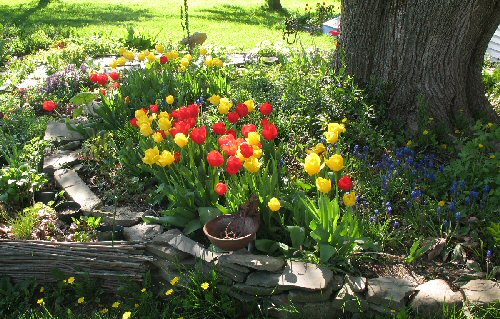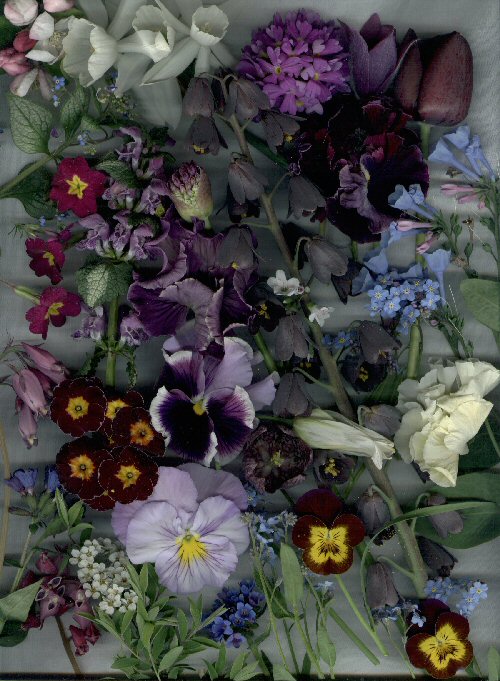Flower has rotten flesh smell is a top video at CNN now. I can’t embed it or link to it directly. If the video isn’t there anymore, try plugging the title of the clip into their search box. (Be sure to click on the cnn.com button, not web.)
Month: May 2007
Midweek music: Mala Vida
‘Cause Julie’s looking for a mosh pit. And I need some energy. If you dare, try the original Manu Chao video. Bizarre. Â Here’s a great acoustic set by Manu Chao (audio only) on Morning Becomes Eclectic.
Rescued tulips (w/poll)
One of the most common questions I get in winter is what to do with forced bulbs after they’re done flowering. I answer that most people treat them like cut flowers and compost them. But I add if that’s what they plan to do to please bring me the pot and plants.
I’ll deadhead them and put them in a sunny window or a cold frame if spring is fast approaching. When the leaves die back, I clip them off and stick the pots some place where they’ll stay bone dry.
Some of the bulbs will rot. Some will whither. But come October, I stick the sound bulbs in the ground. As you can see, it can be worth the effort.
I never buy tulips. They have a tendency to fade away rather than mulitply. And the deer love them, though they seldom graze on the ones I plant close to the house. I think it was Elizabeth over at GardenRant who wrote that the clown colors of tulips like these are a tad gauche. I tend to agree. But for a week or so every spring they make me smile.
Pub preview: Site Assessment for Gardeners
 Most good gardeners have a well-developed sense of place. They are observant. They know their soils. They know their weather and climate. And they’re good at matching plants to the conditions they find where they garden.
Most good gardeners have a well-developed sense of place. They are observant. They know their soils. They know their weather and climate. And they’re good at matching plants to the conditions they find where they garden.
We may take all that for granted. But there are many folk out there who want to garden (or want to be better gardeners) but really don’t have a clue. They need help understanding where to start when it comes to assessing their site.
If you know someone like that, here’s a publication that might help them out: Site Assessment for Gardeners. (Full disclosure: I work for Cornell and am a friend and co-worker of the author.) It the 56-page manual won’t be available in hard copy until fall, but there’s a pre-publication version online.
It’s been field-tested and is undergoing revision. Charlie Mazza, the author, has been working with Master Gardeners in 5 New York counties. The MGs have held workshops to introduce ‘regular’ gardeners to the site assessment process and the publication. He told me today that a good sign is that most of the gardeners who took the workshop intend to follow-up and do a thorough site assessment of their own yards this season.
That’s no small commitment on their part. The 11-step, how-to process includes:
- Garden or landscape area
- Obstructions above and below
- Sun and shade
- Hardiness and microclimates
- Wind
- Compaction
- Drainage
- Soil characteristics
- Wildlife interference
- Existing plants
- Putting it all together
When you complete the process, you’ll have:
- A sketch of your yard with information you’ll need to make important planting decisions for years to come.
- A list of existing plants and how they fit into your future plans.
- A checklist of other physical factors that you have discovered during your site assessment.
Final revisions will take place in June. If you have a chance to look it over in the next few weeks and have suggestions for making it better, you can leave comments here or email Charlie Mazza directly: cpm6@cornell.edu
I’d be especially interested to hear if you think the publication would be valuable for gardeners near you. It was written with Northeast gardeners in mind. But I think the process itself is widely adaptable.
May Garden Bloggers’ Bloom Day Scans: Cool (w/poll)
Too many things blooming to fit them all on one scanner bed, so here are the blooms from the cool side of the color wheel, more or less. (The warm blooms are here.)
I did them with a dark and light background. Take the poll below to let me know which you like best. Click on images for a larger view.



